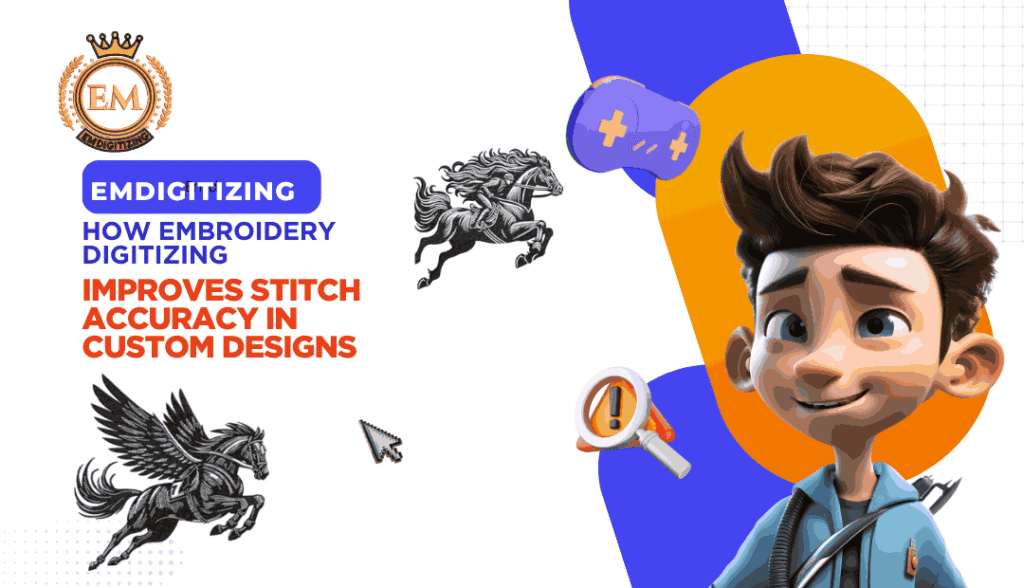
How Embroidery Digitizing Improves Stitch Accuracy in Custom Designs
Embroidery digitizing plays a vital role in transforming artwork into stitch-ready formats for embroidery machines. While the aesthetic appeal of a design is important, stitch accuracy is what ultimately determines the quality, clarity, and durability of the embroidery. Whether it’s for corporate logos, custom apparel, or promotional items, even minor inaccuracies in stitching can ruin the overall impression.
In this blog, we will explore how embroidery digitizing improves stitch accuracy, why it’s crucial for both personal and commercial embroidery projects, and what factors contribute to achieving precise, professional-quality results.
Understanding Stitch Accuracy in Embroidery
Stitch accuracy refers to how precisely each stitch is placed during the embroidery process. It includes elements such as:
-
Proper alignment of stitches
-
Consistent stitch density
-
Clean transitions between stitch types
-
Exact placement of fills and outlines
-
Avoidance of gaps, overlaps, or thread breaks
When done correctly, high stitch accuracy ensures the design appears exactly as intended, regardless of the fabric or garment type.
What Is Embroidery Digitizing?
Embroidery digitizing is the process of converting a visual design or logo into a digital embroidery file that an embroidery machine can read. This process involves:
-
Defining stitch paths
-
Assigning stitch types (satin, fill, run, etc.)
-
Adjusting stitch density
-
Mapping out color sequences
-
Matching the design with the garment type and size
A skilled digitizer uses specialized software to make sure every detail is captured precisely. This attention to detail is what leads to better stitch accuracy.
Key Ways Digitizing Enhances Stitch Accuracy
1. Optimized Stitch Paths
One of the most critical parts of digitizing is creating efficient stitch paths. When stitch paths are optimized, the needle travels smoothly from one part of the design to another without unnecessary movements or jumps. This reduces misalignment and ensures that every element of the design stays where it belongs.
Improper stitch sequencing can cause thread tension issues and design distortion. Proper digitizing avoids this problem.
2. Precise Stitch Types for Each Design Element
Different parts of a design require different types of stitches. For example:
-
Text usually works best with satin stitches
-
Large filled areas may require fill (tatami) stitches
-
Thin outlines benefit from run stitches
Digitizing software allows the designer to choose the most appropriate stitch type for each part of the design. This targeted approach increases stitch accuracy by matching the stitch type to the specific design need.
3. Fabric-Specific Adjustments
A well-digitized file considers the type of fabric being embroidered. Some fabrics, like knits or fleece, stretch or distort under tension. Others, like denim or canvas, are more stable but require higher thread penetration.
Embroidery digitizing allows the user to set compensation values and adjust density to account for fabric behavior. This ensures the stitches stay in place and don’t shift or sink into the material.
4. Underlay Stitches for Foundation
Underlay stitches are used beneath the top stitches to stabilize the fabric and support the design. Digitizing allows control over the type and placement of underlay, which:
-
Reduces puckering
-
Prevents shifting
-
Enhances top-stitch definition
-
Maintains design integrity over time
Without proper underlay, even a beautiful design can look uneven or sloppy.
5. Avoidance of Thread Breaks and Overlaps
Poorly digitized designs often lead to frequent thread breaks or messy stitch overlaps. This wastes time, thread, and increases machine wear.
Proper digitizing reduces unnecessary jumps and trims, places locking stitches where needed, and eliminates overlapping elements. The result is smoother stitching and reduced downtime.
6. Balanced Stitch Density
Too much density can cause thread buildup, while too little can make the design appear patchy or unfinished. Embroidery digitizing allows control over stitch density, balancing coverage with stability.
This is especially important when resizing designs, as different sizes may require density adjustments to maintain accuracy.
Why Stitch Accuracy Matters
Professional Appearance
A clean, precise stitch job reflects professionalism and craftsmanship. This is essential for logos, uniforms, or branding materials where first impressions count.
Durability
Accurate stitching ensures the design holds up over time and withstands washing, wear, and usage without fraying or distorting.
Machine Efficiency
Properly digitized designs run smoothly on embroidery machines, reducing errors, thread breaks, and production delays.
Customer Satisfaction
Whether you’re creating embroidery for a client or for retail, precision is key to delivering results that meet expectations.
The Role of Digitizing Software
Modern digitizing software plays a major role in achieving stitch accuracy. Features like:
-
Stitch simulators
-
Auto pathing tools
-
Density preview
-
Error alerts
-
Fabric preset profiles
…allow the digitizer to see how the design will behave before it ever reaches the embroidery machine. This predictive capability minimizes trial and error and enhances accuracy.
Professional vs DIY Digitizing
Some embroidery enthusiasts try digitizing their own files using entry-level software. While this may work for simple designs, professional digitizing services often produce far superior results, especially for complex logos or commercial work.
The best embroidery digitizing services use high-end tools, experienced digitizers, and quality control processes to ensure every stitch is accurate, efficient, and production-ready.
Common Stitch Accuracy Problems Caused by Poor Digitizing
-
Jagged or wavy outlines
-
Text that appears unreadable
-
Misaligned colors
-
Overlapping sections
-
Gaps in fill areas
-
Design puckering or distortion
All of these issues can be minimized or eliminated through expert digitizing.
Conclusion
Embroidery digitizing is the foundation of precise, professional embroidery. When done correctly, it ensures that every stitch is placed with purpose, resulting in designs that are clean, accurate, and durable. From underlay control to stitch density and path optimization, every aspect of digitizing contributes to improving stitch accuracy.
Whether you’re working on personal projects or commercial embroidery orders, investing in expert digitizing pays off in the form of better results, fewer errors, and more satisfied customers. As embroidery continues to grow in popularity, stitch accuracy will remain one of the most important aspects of quality embroidery production.
Frequently Asked Questions (FAQs)
Q1: Can I digitize my own designs and still get good stitch accuracy?
Yes, but only if you have the right software and a good understanding of embroidery techniques. For complex designs, professional digitizing services are recommended.
Q2: How does fabric type affect stitch accuracy?
Different fabrics stretch, shrink, or absorb stitches differently. Digitizing allows you to adjust for fabric behavior, which improves overall accuracy.
Q3: What is stitch compensation in digitizing?
Stitch compensation accounts for fabric pull or push during stitching. It ensures that shapes and outlines stay in the correct position even if the fabric moves slightly.
Q4: Why is underlay important in digitizing?
Underlay stabilizes the fabric and creates a foundation for top stitches. It helps maintain shape, reduce distortion, and increase stitch accuracy.
Q5: Are automated digitizing tools as accurate as manual digitizing?
While automated tools are improving, manual digitizing by a skilled professional still offers the highest level of control and accuracy, especially for detailed designs.

